 view
larger
|
 The
Evil in Pemberley House, an addition to
Philip José Farmer’s Wold Newton cycle, plays with
the Gothic horror tradition. Patricia Wildman, the
daughter of the world-renowned adventurer and
crimefighter of the 1930s and ’40s, Dr. James Clarke
“Doc” Wildman, is all alone in the world when
she inherits the family estate in Derbyshire,
England—old, dark, and supposedly haunted. The
Evil in Pemberley House, an addition to
Philip José Farmer’s Wold Newton cycle, plays with
the Gothic horror tradition. Patricia Wildman, the
daughter of the world-renowned adventurer and
crimefighter of the 1930s and ’40s, Dr. James Clarke
“Doc” Wildman, is all alone in the world when
she inherits the family estate in Derbyshire,
England—old, dark, and supposedly haunted.
But
Farmer, characteristically, turns convention on its ear.
Is the ghost real, or a clever sham? In Patricia Wildman,
Farmer creates an introspective character who struggles
to reconcile the supernatural with her rational
scientific upbringing, while also attempting to work
through unresolved feelings about her late parents. He
sets the action at Pemberley from Jane Austen’s Pride
and Prejudice and ingrains the various
mysteries in the Canon of the Sherlock Holmes stories.
The
Evil in Pemberley House, by Philip José
Farmer and Win Scott Eckert, is a darkly erotic novel
with broad appeal to readers of pulp and popular
literature, particularly followers of Doc Savage,
Sherlockians, and fans of Farmer’s own celebrated
Wold Newton Family.
|
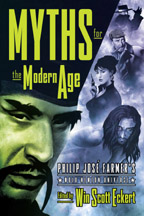 view
larger
|
|



PART I
(Prehistory -
1800)
by Win Scott
Eckert
Search The Wold Newton
Universe
CROSSOVER
STORIES APPEAR IN BLUE TEXT
CROSSOVER
REFERENCES TO SUPERHEROES AND/OR INFORMATION RELATED TO SUPERHERO
UNIVERSES APPEAR IN GREEN TEXT (CLICK HERE FOR A DETAILED EXPLANATION OF HOW SUPERHERO CROSSOVERS
ARE DOCUMENTED ON THIS CHRONOLOGY)
AN
OVERVIEW OF KEY EVENTS IN THE WOLD NEWTON UNIVERSE APPEARS IN
BLACK TEXT - not intended as an all-inclusive history - for
complete information refer to:
Philip José Farmer's Tarzan
Alive, Doc
Savage: His Apocalyptic Life, and The
Other Log of Phileas Fogg
William S. Baring-Gould's Sherlock
Holmes of Baker Street and Nero
Wolfe of West 35th Street
Professor H.W. Starr's articles A
Submersible Subterfuge, or, Proof Impositive
and A Case of Identity, or, The
Adventure of the Seven Claytons
(both articles included as addenda to Farmer's
The Other Log of Phileas Fogg and Tarzan
Alive, respectively)
Rick Lai's article The Secret History of Captain
Nemo, Pulp
Vault number 11, Tattered Pages
Press
Peter Cannon's The
Chronology Out of Time: Dates in the Fiction of H.P.
Lovecraft, Necronomicon Press, 1997
Daniel Harms' The
Encyclopedia Cthulhiana, 2nd ed.,
Chaosium Books, 1998 (including the Timeline
of the Cthulhu Mythos by Shannon
Appel)
Chris Jarocha-Ernst's A
Cthulhu Mythos Bibliography & Concordance,
Armitage House, 1999
Alan Moore and Kevin O'Neill's The
League of Extraordinary Gentlemen,
volumes I and II and the annotations
of volume I and volume II by Jess
Nevins
other works cited on these pages
c. 491,000 BCE -
The time of Thongor, a barbarian warrior of the ancient continent
of Lemuria. The saga of Thongor was told by Lin Carter in a
series of novels: Thongor and the Wizard of Lemuria, Thongor
and the Dragon City, Thongor Against the Gods, Thongor
in the City of Magicians, Thongor at the End of Time,
and Thongor Fights the Pirates of Tarakus. There are
also two short tales of Thongor contained in Carter's volume Lost
Worlds: Thieves of Zangabal and Keeper of the
Emerald Flame. Thongor is associated with the Cthulhu
Mythos, and therefore is part of the Wold Newton Universe.
c. 400,000 BCE -
In the wake of the Fall of Lemuria, many surviving Lemurians
found the first empire of Atlantis. The Lemurians are joined by
other refugees from a crash of a Barsoomian spaceship, including
La, daughter of Tario. More on the fate of La is revealed here. The first empire of Atlantis eventually
falls, giving rise to a second empire.
c. 24,000 BCE -
Time of the fall of the second empire of Atlantis, as told in The
Black Star by Lin Carter. Much of Atlantis sinks.
c. 18,000 BCE -
Robert E. Howard's tales of Kull of Valusia. The remnants of the
great civilization of Atlantis have deteriorated to barbarism,
and Kull is a barbarian warrior from this ancient land. He goes
on to become King Kull of Valusia. Most of Howard's tales of
ancient warriors, including Kull, are connected with the Cthulhu
Mythos, and hence are essential components of the history of the
Wold Newton Universe. The Kull stories are collected in King
Kull, Lancer Books, 1967, and include several fragments
which were completed by Lin Carter.
c. 18,000 BCE -
The Great Cataclysm, a disaster which destroys much of the old
world, signals the beginning of the Hyborian Age. See Robert E.
Howard's The Hyborian Age.
c.
18,000 BCE
 A KING COMES RIDING
A KING COMES RIDING
In 1981, a wounded Spider-Man is tended by Dr.
Strange. However, the only cure for Spidey's injury
lies in the distant past, in the time of King Kull (c. 18,000
BCE). Strange sends Spider-Man's astral body back in
time, where Spidey is able to possess bodies for a short
time. He saves Kull's life, and thus winning the King's
favor, Kull helps Spidey in his quest. Brule the Spear-Slayer
and the ageless druid Tu also appear, as does Dr. Strange's
servant, Wong.
Marvel Team-Up number 112, December 1981,
by J.M. Dematteis, Herb Trimpe, Mike Esposito, and Marie
Severin. Since Robert E. Howard's legendary hero, King Kull,
is in the Wold Newton Universe, an "Elseworlds"
version of Spider-Man also exists in the Newtonverse.
However, this is not the Spider-Man of the Marvel Comics
Universe, which has a significantly different history and
continuity than that of the Wold Newton Universe.
Therefore, the references to the superhero team, "The
Defenders," are fictional, although the Wold Newton
Universe version of Namor was active in the in the 1940s.
(See the crossover rules
for superheroes.) Dr. Stephen Strange has also been
mentioned in a Dr. Zarnak story, so it seems fairly
conclusive that a version of Strange exists in the Wold
Newton Universe. See also Marvelous,
Fantastic Tales in the Wold Newton Universe.
c. 12,000 BCE -
Tarzan arrives from the year 2070 (Time's Last Gift).
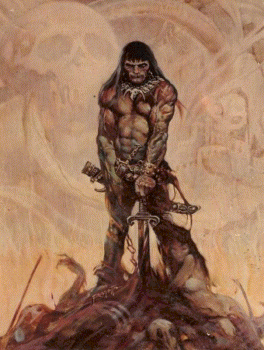 |
c.
10,000 BCE - Coincident with the end of the Hyborian Age
is the time of Conan, a barbarian warrior from Cimmeria.
In tales related by Robert E. Howard, L. Sprague de Camp,
Lin Carter, Roy Thomas, and many others, it has been told
that Conan had many great adventures, eventually becoming
King of Aquilonia. |
c. 10,000 BCE
THE COMING OF
CONAN
Nineteen-year-old
Conan is captured by a shaman who reveals the secrets of the
past and the future. Among the visions revealed is that of
King Kull of Valusia.
Marvel
Comics' Conan the Barbarian issue 1, by Roy Thomas
and Barry Windsor-Smith. The cross-references to Kull are so
numerous throughout the Conan series, it would be
redundant to list them all, so only selected references will
be listed.
c. 10,000 BCE
LAIR
OF THE BEAST-MEN
The Ape-Men who capture young Conan and keep
humans for slave labor all have Mangani names, perhaps
pointing to the distant origin of the tribes which survived
to live in 19th Century Africa.
Marvel
Comics' Conan the Barbarian issue 2, by Roy Thomas
and Barry Windsor-Smith.
c. 10,000 BCE
DEVIL-WINGS
OVER SHADIZAR
Maldiz, the finest blacksmith and goldsmith in
Shadizar, tells Conan that the gold piece he forges for Conan
is "not quite up to a falcon I once forged."
Clearly, the origin of the fabled object
known in the present day as the Maltese Falcon goes much
farther back into ancient history than once was thought. Marvel Comics' Conan the
Barbarian issue 6, by Roy Thomas and Barry Windsor-Smith.
c. 10,000 BCE
A
SWORD CALLED STORMBRINGER
Young Conan fights along side a warrior from
another dimension called Elric of Melniboné.
Issues 14 and 15 of Marvel Comics' Conan
the Barbarian, by Roy Thomas, Michael Moorcock, James
Cawthorn, and Barry Windsor-Smith. The immortal warrior Kane
would also meet Elric, proving that that the various dimensions in
which the Eternal Champion stories occur are alternate
universes to the Newtonverse.
| c.
10,000 BCE - Red Sonja's exploits also take place during
this time period. Her adventures are chronicled in Marvel
comic books, as well as in six novels by David C. Smith
and Richard L. Tierney: The Ring of Ikribu, Demon
Night, When Hell Laughs, Endothor’s
Daughter, Against the Prince of Hell, and Star
of Doom. |
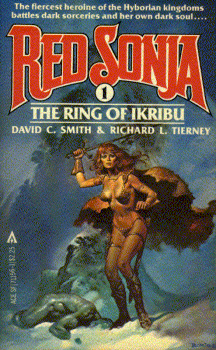 |
c. 10,000
BCE
THE
SHADOW OF THE VULTURE
While trapped during a siege in the city of
Makkalet, Conan meets the amazing Red Sonja for the first
time.
Issues 23 of Marvel Comics' Conan the
Barbarian, by Roy Thomas and Barry Windsor-Smith, freely
adapted from the story by Robert E. Howard. Conan and Red
Sonja would go on to meet and fight together many times. Only
a few of those meetings will be chronicled here.
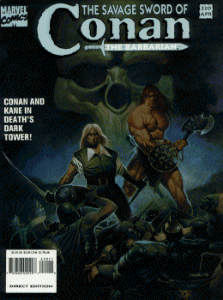
c. 10,000
BCE
DEATH'S DARK
RIDERS
Conan is
traveling through Kush on his way north following the death
of Belit when he falls prey to the sorceries of the city of
Negari. He is transported to the distant past when Negari was
a city of Atlantis, where he has an adventure with Solomon
Kane, who has also been transported to the past.
This tale
in Marvel Comics' Savage Sword of Conan issues
219-220, by Roy Thomas and Colin MacNeil, is a sequel
to R.E. Howard's Solomon Kane story The Moon of Skulls.
c. 10,000 BCE
THE
RAVAGERS OUT OF TIME
Conan of Cimmeria and Red Sonja of Hyrkania
are transported back in time, where they meet King Kull and
fight against the ageless, evil wizard Rotath. Gonar and
Brule the Spear-slayer also appear in this adventure.
Marvel Comics graphic novel published in
1992.
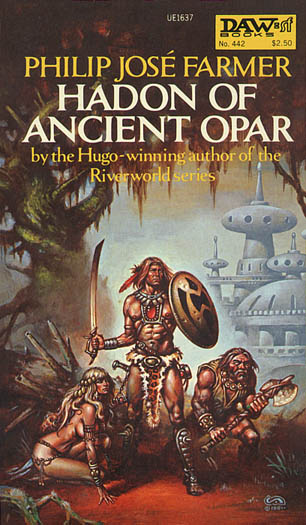
c. 10,000 BCE
HADON OF ANCIENT OPAR
Hadon is a warrior of the
ancient city Opar, the ruins of which will be discovered in
Africa by Tarzan in 1909.
c. 10,000 BCE
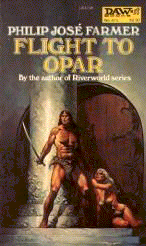 FLIGHT TO OPAR
FLIGHT TO OPAR
More adventures of the
ancient warrior, Hadon of Opar.
These two novels of
Hadon of Opar are by Philip José Farmer and were published
by DAW Books in 1974 and 1976, respectively. Opar is the
locale for several Tarzan books written by Edgar Rice
Burroughs. It should also be noted that the character of the
Gray-Eyed God, Sahhindar, god of plants, of bronze, and of
time, is in actuality Tarzan, who has traveled back in time
(see the entry for Time's Last Gift, year 2070). Please
follow the Allan and the Ice-Gods link to read Mr. Farmer's
thoughts on the relationship between Opar and the
lost cities of H. Rider Haggard's Allan Quatermain.
 c. 9,960 BCE - After a great catastrophe, the son
of Hadon of Opar emigrates to the south and founds the city of
Kôr (see H. Rider Haggard's She, 1884). He carries with
him a huge axe made of meteorite iron, which will eventually be
passed down to Umslopogass, the great Zulu hero, who will shatter
it in the city of Zu-Vendis (Haggard's Allan Quatermain, 1886). Please click here for more
information. Rick Lai adds: "In Haggard's She and
Allan, Ayesha battled a fellow immortal, a giant called
Rezu. This immortal took his name from a ancient sun god
worshipped in Kôr. In Farmer's Hadon novels, the cult of Rezu
(the spelling is changed to Resu) is identified with Opar's cult
of the Flaming God from the Tarzan novels. The physical
description of Rezu in Haggard's novel fits Hadon's cousin,
Kwasin. Haggard's Rezu is either meant to be Kwasin or the
son of Hadon who founded Kôr."
c. 9,960 BCE - After a great catastrophe, the son
of Hadon of Opar emigrates to the south and founds the city of
Kôr (see H. Rider Haggard's She, 1884). He carries with
him a huge axe made of meteorite iron, which will eventually be
passed down to Umslopogass, the great Zulu hero, who will shatter
it in the city of Zu-Vendis (Haggard's Allan Quatermain, 1886). Please click here for more
information. Rick Lai adds: "In Haggard's She and
Allan, Ayesha battled a fellow immortal, a giant called
Rezu. This immortal took his name from a ancient sun god
worshipped in Kôr. In Farmer's Hadon novels, the cult of Rezu
(the spelling is changed to Resu) is identified with Opar's cult
of the Flaming God from the Tarzan novels. The physical
description of Rezu in Haggard's novel fits Hadon's cousin,
Kwasin. Haggard's Rezu is either meant to be Kwasin or the
son of Hadon who founded Kôr."
c. 9,550 BCE -
The Final Cataclysm destroys the remnants of the Hyborian world
in a great deluge, and the modern world begins to take shape.
 c. 3,400 BCE - Events of the feature film The
Scorpion King.
c. 3,400 BCE - Events of the feature film The
Scorpion King.
c.
1200s BCE
SEVEN STARS
Prologue: IN EGYPT'S LAND
At the time
of Exodus, Pai-net'em, a councilor and Pharaoh's scribe to
Meneptah, meets his fate.
Seven Stars,
by Kim Newman, consists of this prologue and seven chapters,
all of which take place at different times throughout
history, and involve different characters. This prologue
takes place during the reign of Meneptah II (which was c.
1200s BCE, according to this Biblical
Chronology; there is also valuable information
available at Digging Up the
Past). Pai-net'em was a real historical figure
whose mummy was discovered in 1881. Although I avoid using
real historical figures to place stories within the Wold
Newton Universe, subsequent chapters of Seven Stars
involve established Wold Newton personages, as well as
incorporate some new characters. Seven Stars (which
can be found in Dark Detectives, edited by Stephen
Jones, Fedogan & Bremer, 1999) also incorporates
characters and the jewel from Bram Stoker's The Jewel of
Seven Stars (1903).
The
action picks up again in June 1897 with Seven Stars
Episode One: The Mummy's Heart, available on the Crossover Chronology, Part V.
 c. 380-335 BCE - The events of Ayesha's
autobiographical tale, entitled Wisdom's Daughter by its editor, H. Rider
Haggard. The final chapter carries Ayesha's story through
the year 1902. Further entries in the saga are She and Allan, She, Ayesha: The Return of
She,
and The Vengeance of She (by Peter Tremayne).
c. 380-335 BCE - The events of Ayesha's
autobiographical tale, entitled Wisdom's Daughter by its editor, H. Rider
Haggard. The final chapter carries Ayesha's story through
the year 1902. Further entries in the saga are She and Allan, She, Ayesha: The Return of
She,
and The Vengeance of She (by Peter Tremayne).
c.
200 BCE - The events of Miles Gloriosus, Pseudolus,
and Mostellaria by Plautus, collectively retold as A
Funny Thing Happened on the Way to the Forum.
27-50
- Exploits of Simon of Gitta, as told by Richard L. Tierney in
tales collected in the volume Scroll of Thoth. These
adventures are associated with the Cthulhu Mythos, and therefore
with the Wold Newton Universe.
January
32
THE
BLADE OF THE SLAYER
Simon of Gitta meets Kane, the immortal
slayer.
Short story by Richard L. Tierney, in the
volume Scroll of Thoth, bringing Karl Edward
Wagner's Kane into the Wold Newton Universe. For more on
Kane, read Mark Brown's article.
Spring
34
THE
SOUL OF KEPHRI
This Simon of Gitta tale mentions "the
sword of the Aquilonian king" and also refers to the
phantom sage Epimetrius.
Short story by Richard L. Tierney, in the
volume Scroll of Thoth. The first reference is to
the Conan tale, The Phoenix on the Sword. Epimetrius
also comes from the Conan stories of Robert E. Howard, L.
Sprague de Camp, and Lin Carter.
Spring 37
THE
RING OF SET
This Simon of Gitta tale refers to the Ring of
Set.
The Ring of Set appeared in R.E. Howard's
Conan tale, The Phoenix on the Sword. Short story by
Richard L. Tierney, in the Scroll of Thoth. The Ring
would surface again in 1934, as seen in Howard's John Kirowan
tale, The Haunter of the Ring.
January 41
THE
SCROLL OF THOTH
Simon pursues the Book of Thoth, the
scroll of Thoth-Amon, who was Conan's old adversary. There
are also references to Pain Lords, whom Red Sonja encountered
12,000 years ago.
Short story by Richard L. Tierney, in the
collection Scroll of Thoth.
206-210
- The adventures of Pict warrior Bran Mak Morn, as related in
tales by Robert E. Howard, the novel Legion from the Shadows
by Karl Edward Wagner, and the novel For the Witch of the
Mists by David C. Smith and Richard L. Tierney.
206
WORMS
OF THE EARTH
Bran Mak Morn's quest for the mystical Black
Stone leads him to the ghastly and foul half-human creatures
of the underground, called the Worms of the Earth.
Worms of the Earth is by Robert E. Howard,
and has been reprinted in: Bran Mak Morn,
Baen Books, 1996; and Cthulhu: The Mythos and Kindred Horrors,
Baen Books, 1987. It has been adapted into graphic format by
Roy Thomas, Tim Conrad, and Barry Windsor-Smith, Cross Plains
Comics, 2000. The creatures featured in this tale are the
same beings seen in Howard's The Children of the Night and
People of the Dark. The Black Stone is also featured
in People of the Dark.
207
KINGS
OF THE NIGHT
Bran Mak Morn summons Kull of Atlantis, king
of Valusia. The ancient wizard Gonar (of England) also
appears in this tale and communicates with his ancestor,
Gonar (of Valusia). It is revealed that Bran Mak Morn is
descended from Kull's compatriot Brule the Spear-slayer.
R.E. Howard links two of his creations,
Kull and Bran Mak Morn, in this story, recently published in Bran
Mak Morn, Baen Books, 1996. The King Kull stories were
most recently published as Kull by Baen Books, 1995,
sans the completed fragments by Lin Carter.
Spring
208
LEGION
FROM THE SHADOWS
Bran Mak Morn again sees Kull, Brule, and
Gonar in a vision. The Children of the Night (aka Worms of
the Earth, aka the People of the Dark) and the Black Stone
also appear.
Further evidence linking Bran Mak Morn and
Kull, in this novel by K.E. Wagner, Baen Books, 1988. Takes
place after Worms of the Earth.
470s-490s
- Exploits of Cormac Mac Art, as originally told by Robert E.
Howard, and expanded upon by Andrew J. Offutt, Keith Taylor,
Richard L. Tierney, and David Drake.
Late 480s
THE
TEMPLE OF ABOMINATION
Kull, Atlantis, and the Old Ones are mentioned
in this Cormac Mac Art adventure.
By Robert E. Howard and Richard L.
Tierney, in the volume Tigers of the Sea, Zebra
Books, 1975. Links Cormac Mac Art, Kull, and the Cthulhu
Mythos.
490
THE
UNDYING WIZARD
THE
SIGN OF THE MOONBOW
Cormac Mac Art encounters the ageless druid
Tu, who was also an advisor to Kull, and it is revealed that
Cormac is the reincarnation of Kull, as well as Conan. Cormac
then battles Kull's ancient enemy, the mage Thulsa Doom.
Andrew J. Offutt's Cormac Mac Art novels
link with Conan and King Kull. Both are linked to the Cthulhu
Mythos, which in turn is part of the Wold Newton Universe.
These are book numbers 6 and 7 in the Cormac Mac Art cycle,
published by Zebra Books in the 1970s and reprinted by Ace
Books in the 1980s. The other books in the series are: 1: The
Mists of Doom by Offutt; 2: The Tower of Death
by Offutt and Taylor; 3: When Death Birds Fly by
Offutt and Taylor; 4: Tigers of the Sea by Howard
and Tierney; and 5: Sword of the Gael by Offutt. The
original R.E. Howard material has also been reprinted in Cormac
Mac Art, Baen Books, 1995, with an original story and
fragments of R.E. Howard's work completed by David Drake.
Late
1100s - The adventures of Robin Hood.
1194
- Sir Walter Scott's Ivanhoe. Ivanhoe, the
basis for Robin Hood's inclusion in the Wold Newton Universe, is
mentioned in J.T. Edson's western novels, which also incorporate
or relate to other members of Farmer's Wold Newton family.
c.
1240s-1250s - The events of Edgar Rice Burroughs' Outlaw of Torn. Philip José Farmer has
postulated that Norman of Torn (aka John Caldwell, aka Richard
Plantagenet) was later known as John Carter, Warlord of Mars
(click here for an informative piece by Mr. Farmer).
 1300 - The events of Emilio Salgari's I
naviganti della Meloria (The Seamen of Meloria).
1300 - The events of Emilio Salgari's I
naviganti della Meloria (The Seamen of Meloria).
1327
- Brother William of Baskerville is embroiled in a series of
murders and intrigue in The Name of the Rose, as related
by Umberto Eco. William must be a member of that family which was
brought to fame in the Sherlock Holmes case, The Hound of the
Baskervilles.
1348
- The events of Sir Nigel, as told by Sir Arthur
Conan Doyle.
1366
- Further adventures of Sir Nigel Loring and The White Company, by Doyle.
1416
- Genevičve Dieudonné is born.
December
1476 - Undeath of Vlad Tepes, the Impaler.
1477
- The events of Dracula Undead (aka Bloodright:
Memoirs of Mircea, Son to Dracula), as related by Peter
Tremayne.
1492-1499
- Young Kit Walker serves as cabin boy to Christopher Columbus,
then explores the New World and discovers the desert mesa which
will be known as "Walker's Table."
Early
1500s - Raphael Hythloday's voyage to the New World land of Utopia, as told by Sir Thomas
More.
1516
- Birth of Kit Walker's son, who will become the first Phantom.
1535
- Death of Captain Kit Walker in a pirate raid; his son, also
named Kit, the sole survivor, washes up on a remote Bangala beach
and is rescued by pygmies. Kit swears an oath on the skull of the
pirate who killed his father that he and his descendants will
fight pirates and evildoers all over the world. He becomes The
Phantom. Wold Newton scholar Dennis Power adds: "When I was
flipping through Addendum 3 (of Tarzan Alive), I noticed
this little bit: 'Tarzan is descended from a number of huge and
powerful men. Hrolf the Ganger, or Walker, was so called because
no horse was big enough to carry his gigantic body.' Perhaps this
may have been the originator of the Walker family, although his
descendants were a bit smaller."
1549 - Solomon
Kane is born to a prosperous Puritan family in Devonshire,
England.
c. Mid-late
1500s - The events of Sir Walter Scott's Kenilworth.
c.
1566 - Solomon Kane embarks on his adventures, as related by
Robert E. Howard.
1574
CASTLE OF THE
UNDEAD
Solomon Kane
and Count Dracula appear together.
Mr. Farmer
has already proposed that Kane was a distant ancestor of many
Wold Newton family members. Kane's existence in the Wold
Newton Universe is confirmed in this story found in issue 3
of Marvel's black and white Dracula Lives magazine
(by Roy Thomas and Alan Weiss), which ran in the early 1970s.
For information on Dracula's inclusion in the Newtonverse,
see the Holmes-Dracula encounter of 1887. Although Marvel
published this story, the Marvel comics universe is not part
of the Wold Newton Universe; see notes under the entry for The
Sting of the Green Hornet, 1942. The complete Solomon
Kane stories by Robert E. Howard have been compiled in Solomon
Kane, Baen Books, 1995.
1575
THE
DRAGON AT CASTLE FRANKENSTEIN
Solomon Kane comes to Nieder-Beerbach where
Castle Frankenstein sits on the northern edge of Magnet
Mountain. The castle was erected in 1250 and houses the local
baronial family, currently ruled by Baron Hans Von
Frankenstein (implicitly an ancestor of the famous Victor
Frankenstein).
Marvel
Comics' Savage Sword of Conan issue 22 by Donald F.
Glut and Sonny Trinidad. The 1531 date referenced in
the story must be discounted in light of the chronology
Solomon Kane's adventures.
1587
RETRIBUTION IN
BLOOD
Solomon Kane
versus Count Dracula.
Issue
number 24 of Marvel's black and white Dracula Lives
magazine.
1588
THE KNIGHT OF LA MANCHA
The 2nd Phantom
participates in the events of Don Quixote.
Issue number 1037 of The Phantom, Frew
Publications, Australia, bringing the events of Miguel de
Cervantes' classic into the Wold Newton Universe.
c.
Late 1500s - The Sea-Hawk, as told by Rafael
Sabatini.
1599
- Birth of Percy Blake (aka the Laughing Cavalier), later known
as Sir Percy Blakeney.
1610 
DEATH'S DARK
RIDERS
Solomon Kane
is abducted from Devon by magical riders from Negari and
taken to that city, now a part of Africa. He is
transported to the distant past when Negari was a city of
Atlantis, where he has an adventure with Conan, who has also
been transported to the past.
This tale
in Marvel Comics' Savage Sword of Conan issues
219-220, by Roy Thomas and Colin MacNeil, is a sequel
to R.E. Howard's Solomon Kane story The Moon of Skulls.
January
1623 - The first Sir Percy Blakeney's first chronicled adventure,
The Laughing Cavalier, as told by Baroness
Orczy.
March
1624 - Events of The First Sir Percy, as related by Baroness
Emmuska Orczy.
1625
- Events of The Three Musketeers, chronicling the
adventures of Athos, Porthos, Aramis, and D'Artagnan, as told by
Alexandre Dumas.
c.
1630 - The events of Shogun, as related by James
Clavell. Other novels in Clavell's "Asian Saga" include
Tai-Pan, Gai-Jin, King Rat, Noble House, Whirlwind, and Escape.
 c. 1635-1661 - The Vicomte de Bragelonne, by
Alexandre Dumas, including: The Vicomte de
Bragelonne, Louise de la Valliere, and The Man in the Iron
Mask.
c. 1635-1661 - The Vicomte de Bragelonne, by
Alexandre Dumas, including: The Vicomte de
Bragelonne, Louise de la Valliere, and The Man in the Iron
Mask.
1645
- Twenty Years After, by Alexandre Dumas.
Mid
1600s - Two rival extra-terrestrial races, the Eridaneans and the
Capelleans, crash on Earth. Over the centuries, both races, which
are very long-lived, will covertly continue their rivalry while
living amongst humans. Many humans will be secretly inducted into
the ranks of both the Eridaneans and the Capelleans, in
furtherance of the conflict. These humans will be given an elixir
allowing them to live at least one thousand years, barring
accidental death. (The Other Log of Phileas Fogg.)
1652
- Birth of Peter Blood.
1655
- Ten Years Later by Alexandre Dumas
1660
- Birth of Lemuel Gulliver.
1664
- Birth of Micah Clarke.
 1666 - The Blazing World is psychically
charted by the Duchess of Newcastle.
1666 - The Blazing World is psychically
charted by the Duchess of Newcastle.
 1670-1678 - John Bunyan’s The Pilgrim's Progress
from this World to that Which is to Come.
1670-1678 - John Bunyan’s The Pilgrim's Progress
from this World to that Which is to Come.
 1673 - Captain Robert Owemuch discovers The Floating Island, Scoti Moria.
1673 - Captain Robert Owemuch discovers The Floating Island, Scoti Moria.
 1682-1683 - The first League of Extraordinary
Gentlemen, comprised of Prospero, Caliban, Ariel, Captain Robert
Owemuch, and Christian, sails on a fateful expedition to The
Blazing World, as told by Alan Moore and Kevin O'Neill in The
New Traveller's Almanac, Chapter One: The British Isles in The
League of Extraordinary Gentlemen II.
1682-1683 - The first League of Extraordinary
Gentlemen, comprised of Prospero, Caliban, Ariel, Captain Robert
Owemuch, and Christian, sails on a fateful expedition to The
Blazing World, as told by Alan Moore and Kevin O'Neill in The
New Traveller's Almanac, Chapter One: The British Isles in The
League of Extraordinary Gentlemen II.
1685
- Captain Blood by Rafael Sabatini.
Further adventures of Captain Peter Blood were told in Captain
Blood Returns and The Further Adventures of Captain
Blood.
Late
1680s - The Phantom battles pirate and Wold Newton family
ancestor Captain Peter Blood, thus placing the multi-generational
Phantoms in the Wold Newton Universe. The Phantom
Chronology states that this is the 5th Phantom and that this
incident took place in 1635. However, Captain Blood had not even
been born in 1635; more likely, it was the 7th or 8th Phantom who
met Blood.
c.
Late 1600s - The events of Lorna Doone: A
Romance of Exmoor, as related by Richard Doddridge Blackmore.
1694
- The main events of John Barth's The Sot Weed Factor
begin with Ebenezer Cooke's appointment as Poet Laureate of
Maryland by Lord Baltimore.
May
4, 1699 - Lemuel Gulliver embarks on his various strange voyages,
as told in Gulliver's Travels, by Jonathan Swift
(click here for more information).
c.
Early 1700s - The Life, Adventures,
and Pyracies of the Famous Captain Singleton as recounted by
Daniel Defoe.
1718
CASCA: THE
PIRATE
Casca sails
the high seas with Blackbeard and other dread buccaneer
chieftains.
Novel by
Barry Sadler. One of the Phantoms battled Blackbeard. Historical
accounts indicate it was the fifth Phantom (see The Phantom
Chronology); however, given the time period, it was
probably the eighth Phantom.
1719
- Birth of Nathaniel "Natty" Bumppo.
1729
- Birth of Christopher Syn.
1740
- Natty Bumppo's stories, The Leatherstocking Tales, by
James Fenimore Cooper, begin here. They are: The Deerslayer (1740-1745), The Last of the
Mohicans (1757), The Pathfinder (1760), The Pioneers (1793), and The
Prairie (1804).
1746
THE
HIGHLANDERS
The time- and universe-traveling Doctor Who
visits the aftermath of the battle of Culloden Moor in
Scotland, a battle in which Christopher Syn's father was
killed.
Episode of the television series Doctor
Who, featuring the second Doctor, and relating to events told
in Russell Thorndike's Doctor Syn on the High Seas.
1749
- The events of Fanny Hill, Or,
Memoirs of a Woman of Pleasure, as told by John
Cleland.
1754
- The events of Doctor Syn on the
High Seas, as recounted by Russell Thorndike, wherein Syn
assumes the identity of the piratical Captain Clegg. Syn's
further adventures were told in Doctor Syn Returns, The Further
Adventures of Doctor Syn, The Amazing Quest of Doctor
Syn, The Courageous Exploits of Doctor Syn, The Shadow of Doctor
Syn,
and Doctor Syn.
1760
- The events of Treasure Island, as told by Robert Louis
Stevenson.
December
5, 1760 - Birth of the second Percy Blakeney (aka the Scarlet
Pimpernel), the great-great-grandson of the first Sir Percy.
July
4, 1776 - Birth of Horatio Hornblower.
1782
- Don Diego de la Vega is born.
1785
A
DUEL OF DEMONS
Count Dracula
and Count Cagliostro appear in this story, in which Dracula
goes to pre-Revolutionary France to offer his services to
Louis XVI as an advisor. Cagliostro is already an
advisor to the King and a rivalry develops. Cagliostro
kills Dracula's loyal servant, whereupon Dracula attacks
Cagliostro's wife, Lorenza, turning her into a vampire.
By Gerry
Conway and Frank Springer, in Marvel's Dracula Lives
Number 5, reprinted in Dracula Lives Annual Number
1. In Dumas' Memoirs of a Physician, Altotus kills
Lorenza by draining her of blood, which he plans to use in an
elixir. The truth is revealed here: it was Dracula who
drained Lorenza. Cagliostro thought that Altotus had done the
deed and killed him. However, Cagliostro soon discovered that
Lorenza was not dead, but was undead. For more information on
Cagliostro, please read Dennis Power's upcoming article, Twisted:
The Fagin Family.
1787
- The events of The Legend of Sleepy
Hollow, as related by Washington Irving.
1787
- The League of Extraordinary Gentlemen of the Eighteenth
Century, whose adventures are as yet unchronicled, is comprised
of a very elderly Lemuel Gulliver, Sir Percy Blakeney and wife,
the Reverend Dr. Syn, Fanny Hill, and Natty Bumppo. Note that Sir
Percy was not married to Marguerite Blakeney at
this time; for the possible identity of the woman identified as
his wife, please read The Demmed Fine
Blakeney Family Tree. In the early
1790s, Sir Percy, his wife Marguerite, and Miss Fanny Hill toured
Europe, as related in The New Traveller's Almanac, Chapter
Two: Europe in The League of Extraordinary Gentlemen II.
July
1789
SHADOW
OVER VERSAILLES
Count
Cagliostro and his wife have returned briefly to Louis XVI's
court; however, they depart quickly, searching for a
"cure" for her vampirism. Dracula, still at
court, then becomes involved in the political machinations of
the impending Revolution. The story concludes with the
storming of the Bastille. The King asks for Dracula's
assistance (with his vampiric powers) to keep order in
France. Dracula refuses and departs.
By Tony
Isabella, John Buscema and Pablo Marcos, reprinted in Dracula
Lives Annual Number 1. Cagliostro was banished from
Louis' court in 1786, after his involvement in the affair of
Marie Antoinette's diamond necklace; my hypothesis is that he
returned briefly in 1789, seeking Dracula's help in curing
his wife. When Dracula refused, Cagliostro found it prudent
to move on. For more information on Cagliostro, please read
Dennis Power's upcoming article, Twisted: The Fagin
Family.
1790
- The events of Mary Shelly's novel Frankenstein, in which Victor
Frankenstein creates the first Creature (click here for more information).
c.
Early 1790s - The events of Jane Austen's Pride and Prejudice. Elizabeth Bennet and
Fitzwilliam Darcy will be present at the Wold Newton meteor
strike in December 1795.
1791-
1792 - The events of The Scarlet Pimpernel by Baroness
Orczy. Sir Percy Blakeney will be present at the Wold Newton
meteor strike in December 1795. (The complete series: The Laughing Cavalier, The First Sir Percy, The Scarlet Pimpernel, Sir Percy Leads
the Band, I Will Repay, The Elusive Pimpernel, The Way of the Scarlet
Pimpernel, Lord Tony's Wife, Mam'zelle
Guillotine, El Dorado: An
Adventure of the Scarlet Pimpernel, Sir Percy Hits
Back, The Triumph of the
Scarlet Pimpernel, The League of the
Scarlet Pimpernel, The Adventures of
the Scarlet Pimpernel, A Child of the
Revolution, In the Rue Monge and The Pimpernel and Rosemary.)
1790s-early
1800s - The Exploits of Brigadier Gerard and The Adventures of
Gerard (the Napoleonic stories) by Sir Arthur Conan
Doyle.
1792
THE MAN WHO KILLED THE KING
Roger Brook, a British spy
during the French Revolution and the Napoleonic Wars,
proposes to Prime Minister William Pitt that an secret
organization be created to rescue Frenchmen from the
guillotine. Pitt responds that such an
organization, the League, has already be created by
a prominent member of the British nobility: "Are you
perchance acquainted with Sir
Percy Blakeney?" Brook mentions that he had
heard of Blakeney, but never met him. Brook
learns from Pitt how to contact the League inside
France. After traveling to France, secret messages are
conveyed by the League from Brook to Pitt during
1792-94.
Dennis Wheatley wrote
this series of historical adventures. Wold Newton expert Rick
Lai, who supplied this crossover, notes that, "Although
the words "Scarlet Pimpernel" are never uttered,
there is little doubt that Wheatley is connecting his
characters with Baroness Orczy's. It should be noted
that the concluding chapters of The Man
Who Killed The King, revolving around the fate of the
Dauphin (Louis XVII), directly contradict Orczy's Pimpernel
novel, El Dorado: An Adventure of the Scarlet Pimpernel."
June
1794 - April 1798 - The first volume in Horatio Hornblower's
biography, Mr. Midshipman Hornblower, as related by C.S.
Forester.
December
13, 1795 - Wold Newton meteor strike: Eighteen
individuals "were riding in two coaches past Wold Newton,
Yorkshire.... A meteorite struck only twenty yards from the two
coaches.... The bright light and heat and thunderous roar of the
meteorite blinded and terrorized the passengers, coachmen, and
horses.... They never guessed, being ignorant of ionization, that
the fallen star had affected them and their unborn." Tarzan
Alive, Addendum 2, pp. 247-248. The meteor strike was
"the single cause of this nova of genetic splendor, this
outburst of great detectives, scientists, and explorers of exotic
worlds, this last efflorescence of true heroes in an otherwise
degenerate age." Id., pp.230-231.
1796
 THE FRANKENSTEIN / DRACULA WAR
THE FRANKENSTEIN / DRACULA WAR
While
attempting to live a "normal" life among men, the
Frankenstein Monster is blackmailed by the almost-immortal
Count de Saint-Germain into attacking Count Dracula. Dracula
refers to tales of a monstrous golem, in Prague. After
various events, in which the Creature and Dracula almost
become allies, they once again turn on each other and
eventually fight to a standstill.
Comics
mini-series by Roy Thomas, Jean-Marc Lofficier, Claude St.
Aubin, Allen Nunis, and Armando Gil, Topps Comics, 1995.
After these events, the Monster heads back for the Arctic,
and the events of Black as the Pit, From Pole to Pole
transpire. The tale of the Golem of Prague is the story of the creation of a
golem, a man, or Homunculus, crafted out of clay by a Rabbi
known as the Maharal, in order to protect the Sixteenth
Century Jews of Prague from persecution.
c. 1800-1819
BLACK
AS THE PIT, FROM POLE TO POLE
Frankenstein's Creature travels through a hole
in the Arctic, and thence through a series of inner worlds,
before emerging at the locale of At the Mountains of
Madness in the Antarctic. Arthur Gordon Pym, Mocha Dick,
Otto and Axel Lidenbrock, and Abner Perry, all either appear
or are mentioned.
This story by Steven Utley and Howard
Waldrop was originally published in New Dimensions 7;
it is reprinted in Eternal Lovecraft, Jim Turner,
ed., 1998. The story links together Shelley's Frankenstein,
Lovecraft's Cthulhu Mythos stories, Poe's Arthur Gordon
Pym, Melville's Moby Dick, Verne's Journey
to the Centre of the Earth, and E.R. Burroughs' Pellucidar
series. The story features the original Frankenstein Monster,
not the monsters that were created much later, such as that
seen in a series of films from Universal Pictures. For more
information, please click here.
END OF PART
I
Go To

The Wold
Newton Universe Crossover Chronology was created for the sole purposes
of entertainment and information.
All rights
reserved. The text and design of this page are © 1997-2004 by
the author, Win Eckert.
No copying or reproduction of this article or any portions
thereof in any form whatsoever is permitted without prior written
permission and consent of the author.
(This means that
if you want to post your own version of Wold Newton continuity
and wish to post the text of this Chronology, in whole or in
part, as a basis for your version of the continuity, you are
legally obligated to ask my permission first.)
The author
claims no interest in nor ownership of any images used in the
creation of this site, with the exception of the Wold Newton
banner, which is © 2000-2004 by Lisa Eckert.

 The
Evil in Pemberley House, an addition to
Philip José Farmer’s Wold Newton cycle, plays with
the Gothic horror tradition. Patricia Wildman, the
daughter of the world-renowned adventurer and
crimefighter of the 1930s and ’40s, Dr. James Clarke
“Doc” Wildman, is all alone in the world when
she inherits the family estate in Derbyshire,
England—old, dark, and supposedly haunted.
The
Evil in Pemberley House, an addition to
Philip José Farmer’s Wold Newton cycle, plays with
the Gothic horror tradition. Patricia Wildman, the
daughter of the world-renowned adventurer and
crimefighter of the 1930s and ’40s, Dr. James Clarke
“Doc” Wildman, is all alone in the world when
she inherits the family estate in Derbyshire,
England—old, dark, and supposedly haunted.








 FLIGHT TO OPAR
FLIGHT TO OPAR 